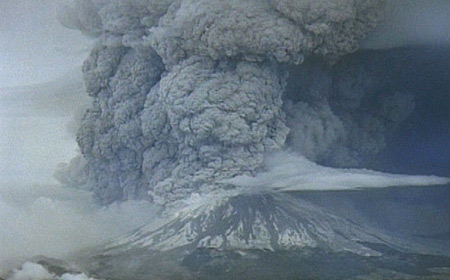 Rivers of moisture: super-storm systems now span across the globe
Rivers of moisture: super-storm systems now span across the globeFebruary 6, 2011 – This fascinating satellite picture from the Japan Meteorological Agency of the Southern hemisphere perhaps demonstrates better than any other just how the planet’s weather patterns are rapidly morphing. On February 6, 2011, a band of moisture stretched from Australia to Antarctica. Cyclone Yasi’s length spanned the width of the continental U.S. Arkstorm systems, known as Rivers of water, similarly span across the Pacific to California. The recent Ground hog day winter storm system that struck the U.S. was 2100 miles long. Jupiter’s planetary storm has raged for centuries and in 2011, scientists were alarmed to find the super-storm on Saturn had now morphed to stretch across almost an entire hemisphere of the planet. There is no longer any doubt Earth’s climatic patterns are in the midst of major epochal change.
 Iceland Professor Issues Warning About Volcano Tremors
Iceland Professor Issues Warning About Volcano Tremors “Seismic activity was detected in the northwestern part of Vatnajökull glacier over the past few days and there is full reason to be on the alert, according to geology professor Páll Einarsson. More earthquake sensors are needed, he said. The series of earthquakes occurred close to Kistufell and Bárdarbunga, which are among the most geologically active areas in the country, ruv.is reports. “A few systems come together there. The largest is the Bárdarbunga system, which includes Veidivötn and Vatnaöldur and stretches way north of Dyngjujáls and west of Askja. Then there is the Grímsvötn system which lies further to the east,” Einarsson explained. He said Bárdarbunga itself and a fissure swarm to the northeast of it seem to be the most active right now. However, it is difficult to tell whether the tremors that are occurring now are a consequence of that eruption or whether another eruption might be coming up. “It is indisputable that the seismic activity is growing steadily in the area—the series of earthquakes over the past few days is an indicator of that. There is full reason to be on the alert.
http://theextinctionprotocol.wordpress.com/6.2 quake rattles the Solomon IslandsPosted on February 7, 2011 by The Extinction Protocol
February 7, 2011 – SOLOMON ISLANDS — A magnitude -6.2 earthquake rumbled under the Pacific Ocean south of Papua New Guinea and the Solomon Islands on Tuesday morning, the U.S. Geological Survey reported, but no tsunami alert was issued. There were no immediate reports of damage or injuries, or even that the temblor was felt in the Solomons or to the east in Papua New Guinea. The 6:53 a.m. Tuesday (local time, 1953 Monday GMT) quake was some 257 miles (414 kilometres) deep, the USGS said. The USGS said the quake hit some 65 miles (110 kilometres) southwest of Arawa, the capital of Bougainville province in Papua New Guinea, and about 95 miles (150 kilometres) southwest of Chirovanga in the Solomon Islands. -AP
Tropical Cyclone Zaka heads for New ZealandPosted on February 7, 2011 by The Extinction Protocol
February 7, 2011 – NEW ZEALAND – A Tropical Cyclone named Zaka by the Nadi Weather Office formed close to Tonga early this morning and is now tracking southwest towards the New Zealand area. Duty Forecaster at the Nadi Weather Office confirmed that the system developed rapidly overnight on the outskirts of Fiji waters at around 1 o’clock this morning. He said the system will not have any direct or indirect effect on the Fiji group due to its current location and projected path. The weather office said the system is now in New Zealand’s area of responsibility and they are closely monitoring Tropical Cycl
Zoo animals freeze to death in coldest winter to hit Mexico in 60 yearsPosted on February 6, 2011 by The Extinction Protocol
February 6, 2011 – CIUDAD JUAREZ, Mexico (AP) — Thirty-five animals at a zoo in the northern Mexico state of Chihuahua have frozen to death during the region’s coldest weather in six decades. Serengeti Zoo owner Alberto Hernandez says 14 parrots, 13 serpents, five iguanas, two crocodiles and a capuchin monkey died. He said Saturday that power failures cut off electrical heating at the zoo in the town of Aldama. Temperatures have dropped to 9 degrees Fahrenheit (minus 13 Celsius) in the area, the coldest weather in 60 years. Power outages have affected much of northern Mexico, forcing factories and businesses to close. Dozens of people are in shelters. Schools have been closed in Chihuahua state but are expected to open Tuesday as the weather warms.” -AP New
Earthquake swarm in Western Turkey
A flurry of seismic activity is occurring in Western Turkey- including some 18 quakes today
Timaru, New Zealand sees hottest day ever recordedFebruary 6, 2011 – NEW ZEALAND – Timaru has broken the record for their hottest day ever with the temperature hitting a scorching 40.3 degrees shortly before 4pm today. The extreme heat, which WeatherWatch.co.nz predicted yesterday, is connected to the same heat wave that saw Sydney climb to 42 degrees yesterday and then recorded their hottest night ever. WeatherWatch.co.nz says Timaru has hovered around 39 degrees for much of the day but peaked at 40.3, breaking their previous record of 39.7 degrees recorded in February 1973. Weather analyst Richard Green says it was a similar Australian/New Zealand heatwave back in 1973 too. “Sydney reached 27.6 as their overnight low last night, beating their record by a whole degree set in February 1973. That same heat wave also hit Timaru in 1973 and again today that record has been broken by point six of a degree”. The heat has been widespread too with WeatherWatch.co.nz readers reporting highs in the late 30s and around the 40 mark this afternoon across Canterbury. Other centres to melt in the heat today were Christchurch, Alexandra, Ashburton, and Oamaru who all reached 36 officially, although private weather stations within Christrchurch were closer to 40. -Voxy.NZ


































